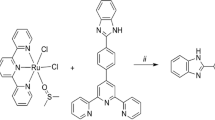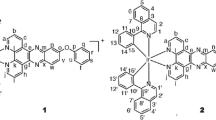Abstract
Gallbladder cancer (GBC) is highly prevalent in Chile and some southern regions of Colombia. This cancer presents low survival rate and poor prognosis in advanced stages. At this respect, the search for new drugs with better selective activity is necessary, among them ruthenium complexes represent an alternative for the development of more efficient drugs for the treatment of GBC. The objective of this study was to determine the in vitro cytotoxic activity of a novel complex based on Ruthenium (II) on the GBC cell line G-415 vs the non-tumor cell line HEK239 using MTT assay. The cell viability of the experiments showed a significant activity of the treatments in tumor cells.
Preview
Unable to display preview. Download preview PDF.
Similar content being viewed by others
References
MINSAL. (2004). Registro Poblacional del Cáncer. Provincia de Valdivia, Chile.
Anderson Rocha-Buelvas, Elizabeth Trujillo-Montalvo, Carlos Hidalgo-Patiño, Angela Hidalgo-Eraso, (2010). Carga de Cáncer del Departamento de Nariño y Subregiones. Revista de la Escuela Nacional de Salud Pública.
Bruijnincx, Pieter C. A. and Sadler, P. J.. (2008) New trends for metal complexes with anticancer activity. Current Opinion in Chemical Biology, Vol.12 (No.2). pp. 197-206. ISSN 1367-5931
William M. Motswainyana and Peter A. Ajibade.(2015) “Anticancer Activities of Mononuclear Ruthenium(II) Coordination Complexes,” Advances in Chemistry, vol. 2015, Article ID 859730, doi:10.1155/2015/859730
Irena Kostova. (2006). Ruthenium Complexes as Anticancer Agents, Current Medicinal Chemistry, vol 13 Page: [1085 - 1107], doi: 10.2174/092986706776360941
Claire S. Allardyce and Paul J. Dyson. (2001). ruthenium in medicine current clinical uses and future prospects. Platinum Metals Review
Ramesh B. Badisa, Selina F. Darling-Reed, Patrick Joseph, John S. Cooperwood, Lekan M. Latinwo And Carl B. Goodman. (2010) Selective Cytotoxic Activities of Two Novel Synthetic Drugs on Human Breast Carcinoma MCF-7 Cells. anticancer research2993–2996.PMCID: PMC2885965
Chanchal Bhaumik, S. D. (2010). Synthesis, Characterization, Photophysical, and Anion-Binding Studies of Luminescent Heteroleptic Bis-Tridentate Ruthenium(II) Complexes Based on 2,6-Bis(Benzimidazole-2-yl)Pyridine and 40. Inorganic Chemistry, 5049 – 5062, doi: 10.1021/ic100138s.
Badisa RB, Lambert AT, Ikediobi CO, Walker EH. (2006) Selective anticancer activity of pure licamichauxiioic-B acid in culture cell lines. Pharmaceut Biol., 141–145.
Paula María Jaramillo y Sergio Iván Hoyos. (2009). Carcinoma de vesícula biliar en el Hospital Pablo Tobón Uribe de Medellín. Revista Colombiana de Cirugia, 250-257
Juan Valle, M.D., Harpreet Wasan, M.D et al. (2010) Cisplatin plus Gemcitabine versus Gemcitabine for Biliary Tract Cancer, New England Journal of Medicine. doi: 10.1056/NEJMoa0908721
Thongprasert S, Napapan S, Charoentum C, Moonprakan S. (2005) Phase II study of gemcitabine and cisplatin as first-line chemotherapy in inoperable biliary tract carcinoma. Annals of Oncology; 279-81. PMID: 15668284
Ariadna Grau-Campistany, Anna Massaguer, Dolors Carrion-Salip, Barragan Flavia, Gerard Artigas, Paula Lopez-Senin, Virtudes Moreno, and Vicente Marchán. (2013) Conjugation of a Ru(II) arene complex to neomycin or to guanidinoneomycin leads to compounds with differential cytotoxicities and accumulation between cancer and normal cells, Mol. Pharmaceutics, doi: 10.1021/mp300723b
Xin Li, Kirsten Heimann, Fangfei Li, Jeffrey M. Warner F. Richard Keene and J. Grant Collins. (2015) Dinuclear ruthenium(II) complexes containing one inert metal centre and one coordinatively-labile metal centre: syntheses and biological activities, DaltonTransactions; doi: 10.1039/c5dt04885k
Author information
Authors and Affiliations
Corresponding author
Editor information
Editors and Affiliations
Rights and permissions
Copyright information
© 2017 Springer Nature Singapore Pte Ltd.
About this paper
Cite this paper
Villota, H., Pizarro, S., Gajardo, F., Delgadillo, Á., Cortés-Mancera, F., Bernal, G. (2017). Selective cytotoxicity of a novel compound based on Ruthenium II in a Gallbladder carcinoma cell line. In: Torres, I., Bustamante, J., Sierra, D. (eds) VII Latin American Congress on Biomedical Engineering CLAIB 2016, Bucaramanga, Santander, Colombia, October 26th -28th, 2016. IFMBE Proceedings, vol 60. Springer, Singapore. https://doi.org/10.1007/978-981-10-4086-3_74
Download citation
DOI: https://doi.org/10.1007/978-981-10-4086-3_74
Published:
Publisher Name: Springer, Singapore
Print ISBN: 978-981-10-4085-6
Online ISBN: 978-981-10-4086-3
eBook Packages: EngineeringEngineering (R0)




